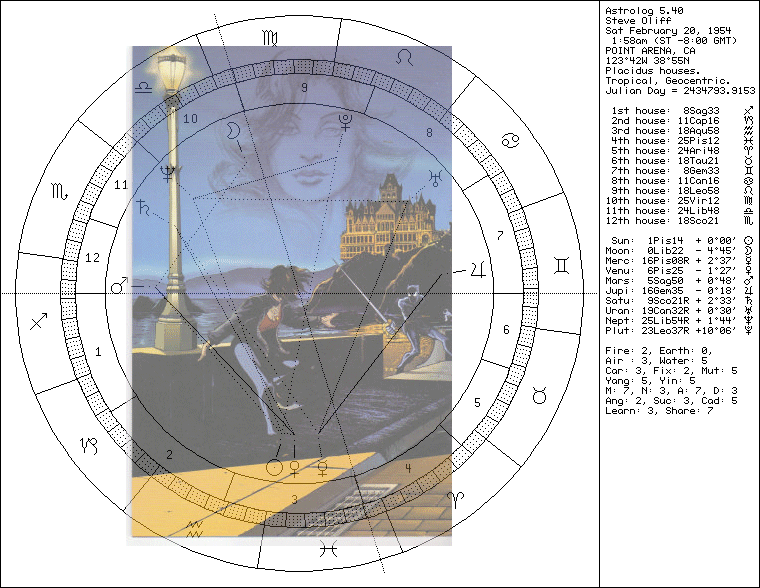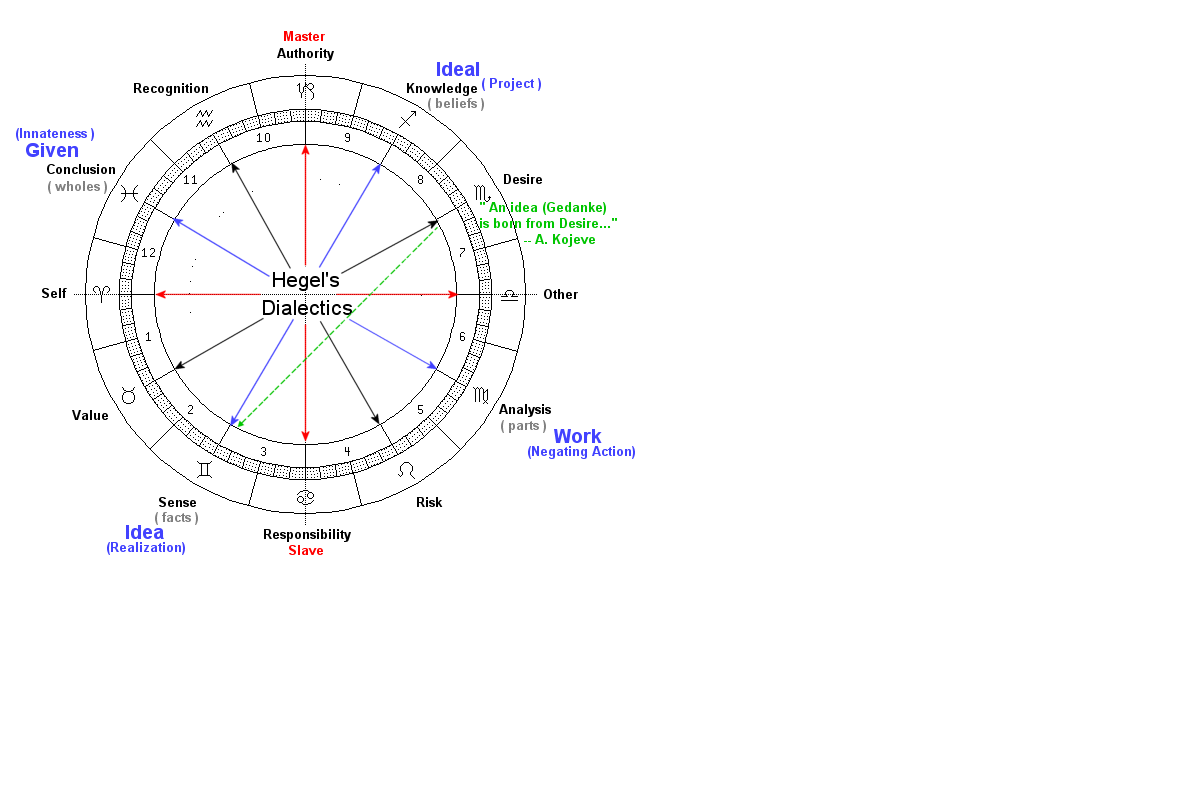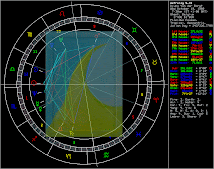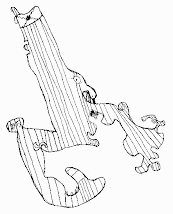
Having taken up a renewed interest in Ayn Rand, I thought I would do a search for a quotation in which Rand uses a figure of speech, and see if I could relate that to her natal chart in terms of the visual positioning of birth planet placement. I got lucky on the first quote I found, and here it is:
from:
http://www.mondopolitico.com/ideologies/atlantis/whatisobjectivism.htm"[..] Ayn Rand was as much an advocate of philosophy in general as she was of Objectivism in particular. She made the point that, whether you have chosen to study philosophy or not, everyone holds beliefs consciously or unconsciously that give rise to, at least, an implicit or subconscious set of principles. As Ayn Rand put it:
"You have no choice about the necessity to integrate your observations, your experiences, your knowledge into abstract ideas, i.e., into principles. Your only choice is whether these principles are true or false, whether they represent your conscious, rational convictions - or a grab bag of notions snatched at random, whose sources, validity, context and consequences you do not know, notions which, more often than not, you would drop like a hot potato if you knew. [..]"
I wondered if the assertive Ayn Rand would give us a projection of natal Mars, but being that Mars was on the very bottom of the chart, I couldn't imagine how this might be accomplished, especially since females generally do not get involved with sharp objects like spears , swords, knives, etc. . However they do refer to Mars as something hot, and here the trite sounding trope is simply about something to hot to hold on to, "drop like a hot potato".
This quote, like most figurative language, is a combination of ideas and images, or better, ideas in the form of images. The processing of human language seems very involved with the brain's processing of visual information, if you see what I'm saying, here... : )
[
a little update/addition : ]
Thanks to a bit of feedback, I see another quote worth citing after having looked for Rand's first novel:
http://en.wikipedia.org/wiki/Ayn_Rand[..]
Her first novel, the semi-autobiographical, We the Living, was published in 1936. Set in Soviet Russia, it focused on the struggle between the individual and the state. In the foreword to the novel, Rand stated that We the Living "is as near to an autobiography as I will ever write. It is not an autobiography in the literal, but only in the intellectual sense. The plot is invented, the background is not..." [..]http://quotes.livejournal.com/6730364.html[..]
"It's because...you see, if we had souls, which we haven't, and if our souls met--yours and mine--they'd fight to the death. But after they had torn each other to pieces, to the very bottom, they'd see that they had the same root." [..] --Ayn Rand, from, We the Living
Its handy for us when author's admit that they are being autobiographical. This being Rand's first novel allows me to think that it probably is a better (less diluted) sort of Self-expression than in later works. There's something about a freshness in art which usually occurs earlier than later; maybe not on the very first try, but certainly before a certain sophistication of self editing renders works less personal, or less raw, whatever the right word here. In reading the above quotation our mind's eye is directed again to the lowest point--to the "bottom. " What could be more at "root," concerning this aggressiveness, as described, than natal Mars--the potential for violent aggression which the author definitely intends to explicitly address?
(Illustration: Any Rand's natal chart showing Mars at the lowest point possible, visually.)
http://pedantus.free.fr/Rand_Ayn_01a.gifFrom the standpoint of, well, perhaps ego psychology, it appears that the projection of the Self is complete, in that the
other here seems assumed to be just the same as, a mirroring of, the speaking character (--who is the author herself, for my purposes).
Why do I bother to do such a silly seeming exercise ?Astrology when limited to a search for a Helgelian sort of understanding of Individualism lets us practice thinking of persons as integral parts of a whole, which is of course humanity in all its varied possibilities. But, some people aren't aware that Hegel did talk about the phenomenology of the Self as truly being an individual existence in its own right. So, I'd better clear that up for any anti-Hegel readers.
[..] In Hegel's thought we can find the beginnings of the distinctly "modern" self -- a self emphasizing the unique personality and the idea of individual freedom -- in particular the freedom to express and actualize the unique individual will. In the Phenomenology of Mind Hegel developed his logic of individual growth to increasing levels of self-awareness. While the ultimate goal in his philosophy was to link the individual with a collective community of like spirits, his self begins that search toward self-actualization through an individual subjective encounter with the material world. [..] (--Neala Schleuning) http://library.nothingness.org/articles/SA/en/display/292
The phenomenon of a given individuated person (Hegel's' term, a "Self-consciousness" ) can be seen as the successful manifestation and transmission of certain Particular Universals which apparently dominate a human being
as if these options for being are the result of some kind metaphysical 'genetic' inheritance. My metaphysics are injected here of course, Hegel doesn't admit any relationship to astrology as holistic philosophical structure. And I don't admit any relationship to Hegel's statist political vision, whatever. For an astrologist, individuals and a required individualism absolutely do exist, as they say, in-and-for themselves. The variously distributed elements of astrological 'influences' are here considered particular universals simply assumed available via the time-ordered lottery of possible celestial inheritances, these obstensibly seeking manifestation in each, more or less, unique individual human being.
The beauty of this natal chart art view, horoscopic expressionism, is how little it matters
what one says or thinks, but rather,
how one says it--how one depicts one's Self in the form of an appreciable linguistic figure. It helps always to remember that persons are all, at some moment, engaged in abstract self-portraiture as a means to 'being there' for us--a way for someone to be objectively observable to us. However, creativity, a creative act of some kind, seems the only way out of the isolation of one's individual mind and into the the mind of another as perceiver of our presence in the world of human beings. Our individual presence in the world, our being as a separate person, cannot simply be a random quotation of another person's existence. If not successful at this art of being an individuated presence, by way of one's own creativity, then we run the risk of simply becoming objectivised, and probably cataloged in someone else's expedient collective human typology and its socially devised nomenclature. We remain a kind of 'thing' that is more brute physical presence than a spiritually present human entity.
One of the reasons I like the spirit/mind of Hegel, or his Phenomenology, is that he too saw that we can turn everything around to find truth in just about any proposition, and thus while I detest the stated aims of Ayn Rand's "Objectivism," I too am a kind of objectivist. I can quite without the slightest quiver of conscience treat Ayn Rand as an object for my dissection . And, in so doing, I can find her both as an interesting object, and as a subject capable of eliciting my spontaneous compassion. What choices did she have, how did she choose, and how do I fairly judge her choices for Self-expression.
Here then is an illustration of Ayn Rand's birth chart relationship to the Hegelian/Marxist philosophical structure which so animated her that she seems inextricably entangled within in it.
http://pedantus.free.fr/Ayn_Rand-v-HegelsDialectics_01a.gifThough we like to imagine that we have a great deal of choice in how we align ourselves with social expectations and such, I think there are many uncatalogued mental 'illnesses'--like the hundreds of trivial viruses which go unidentified and unnamed due to the small impact these have on our basic vitality, their impairments not being anywhere near fatal even if to become chronic. As well, she may have actually been a true sociopath, but there is no way I could actually know such a thing. But these socially unpleasant forms of one's being-one's-self, seem not so much the products of an enabling 'creativity' but as a social burden and a form of personal suffering which apparently can become a chronic
dis-ease. This then is how I see Ayn Rand; her creative offerings as the product of her personal suffering which she projects out upon the world, the objectified world of an Ayn Rand. She is of course attempting to be herself, but perhaps narcissistic-ally trying to
be more a Universal rather than merely a very ordinary sort of an inherited collection of particular universals which are ubiquitously available to the spirit/mind/consciousness, and are routinely worked into any soul's personal art of individuation--the creative act of Self potential (Identity) being (with learning and effort) made manifest as socially significant Being.
That existence which we see and come to know as another individual seems totally dependent on the learned creative use of language as the outlet facility for natal chart-like sets of particularized inheritance of universals. Simply put, Ayn Rand, at one moment in time, solved the need to project her personally particular inheritance of what astrology calls Mars by employing the common trope,
drop like a hot potato. This creative choice gives a measure of Ayn Rand-ness to an otherwise hopelessly cliched figure, by
pointing to where we will find Mars visually located in her chart. In making this observation we have totally objectivised Ayn Rand... : )










